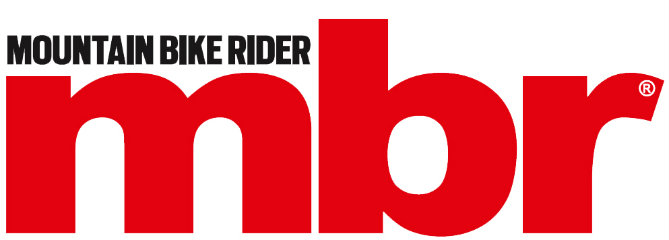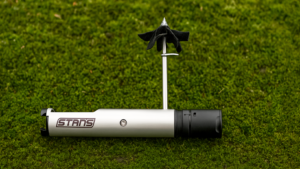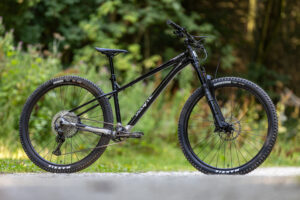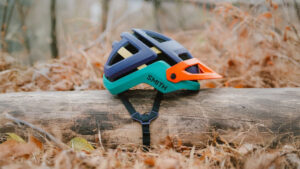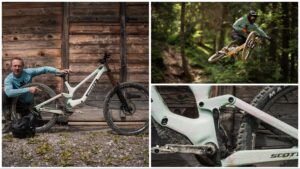The latest generation Butcher Grid Gravity T9 TLR tyre from Specialized is like a slimmed-down DH tyre. Great for all-round use, it only slips up in proper mud.
“It grips like stink” – the new Specialized Butcher gets more rubber, more weight and more damping, but it’s still amazing value
Specialized’s Butcher has been around for well over a decade, but is now a very different beast to the first generation. It started life with an all-round tread much like a Maxxis Minion DHR II and was in fact even originally made by Maxxis’s parent company CST.
My best guess is that at some point CST felt the Specialized tread pattern eating into its own Maxxis sales and undercutting on price, and the manufacturing relationship ended.

We’ve been riding the new Butcher on the latest S-Works Turbo Levo Gen 4 for over six months, and it offers glue-like traction on this bike
What happened next wasn’t great for Specialized: A few years in the wilderness with sub-par products and rubber compounds that didn’t work quite right, until it took control of its own tyre manufacturing from start to finish around four or five years ago.
Since that point – which also marked the launch of the T-series rubber blends like T7 and the softer and slower rebounding T9 compound – the brand has taken performance and grip right back to where it needed to be, with some of the best mountain bike tyres around.

Every other shoulder block now gets a ribbed or feathered square of rubber, it’s raised to give the tyre more bite into smoother surfaces
By my reckoning, this is now the third generation Butcher. And one of the best things about the whole Spesh redesign journey is how the brand continues to refine and develop its tyres while maintaining super-competitive prices, and never seems to bump its full R&D cost on to the consumer.
This thick and tough double-ply Gravity casing tyre therefore has a recommended price of £55, which is pretty much the same as it’s been for years. So as well as being great value, it’s also a solid £30 or so cheaper than popular rivals like Maxxis, Schwalbe, Michelin and Continental DH tyres.
Design and specifications
The biggest change here over the previous generation Specialized Butcher T9 tyre I’ve previously reviewed, is a blockier, tread pattern that Spesh says lays down 12% more rubber on the ground. The lugs are significantly bigger on the shoulders; each edge knob is more splayed out than before, the gaps are more tightly spaced and it also has a file tread section on top of the knobs much like the newer Specialized Hillbilly Grid Gravity T9 and Cannibal models.
It’s abundantly clear this new Butcher owes a chunk of inspiration to the DH Cannibal used by multiple World Champ Loïc Bruni; not least in its broad, sipe-laden, rubber edge cubes.

The shoulder blocks are so prominant now they almost overlap with the central line of lugs, laying down more rubber in hardpacked conditions
Not only are the new Butcher blocks wider all over, each one is also taller and more offset. This means that each shoulder block now almost alternates with the central paddles, which is claimed to deliver a smoother transition from its central blocks to the edges when leaning the bike. Every other edge knob is now L-shaped too – somewhat like the Maxxis Minion DHR II that inspired the Butcher – rather than the funky wiggly shape of old.
The broader base on the shoulder knobs should also make them more resistant to shearing off prematurely, which is a complaint I’ve heard elsewhere. But to be fair, it’s not a problem I’ve experienced myself with older generation Butchers.

The Kryptotal tyre with its SuperSoft compound is lighter than the new Butcher, and wears better too
More rubber obviously means more weight. I measured this 29×2.4in Grid Gravity model at 1,330g, which is at the heavier end of the spectrum for a DH casing, and around 120g heavier than an equivalent Continental gravity range Kryptotal FR for example.
On this note, am I the only one thinking that tyres just keep getting heavier and heavier? What happened to sub 1kg enduro tyres? Even the new Butcher Grid Trail version is 1,050g, whereas it used to be just under a kilo.
The extra rubber should (in theory) also offer better puncture resistance with less space for pointy things to penetrate and an overall tougher and stiffer casing.
This can only be a good thing too considering I previously found the old Specialized Grid Trail casings far too puny to handle riding in the Lakes or somewhere really rocky. They were much easier to puncture than a Maxxis EXO+ that is a very similar weight. I’ve yet to try the Trail casing of this new tread pattern to test this theory though.

The Gravity T9 casing is among the best I’ve tried in terms of puncture protection
In terms of construction and casing, this Gravity version uses two plies of 60tpi (threads per inch) fabric, a wraparound reinforced layer and extra sidewall protection. In contrast, the Trail version uses a single ply 60tpi carcass with a wraparound reinforced layer and smaller sidewall protection zones. New Butcher models come in 27.5in and 29in size in either a 2.4in or 2.6in width (the 2.4in version here replaces the old 2.3in version).
The new Butcher is now only available in the softest, slower rebounding (and slower rolling) T9 compound. There’s therefore no longer a faster and more hardwearing T7 version, so you’ll need to look to the new Eliminator for a longer lasting, faster rolling, but slightly less grippy rear option.
Incidentally, this new Eliminator is also beefed up with bigger blocks and a more aggro outlook that makes it look far more appealing as a rear option for more aggressive riding than the slightly weedy outgoing model. Watch this space for a full review.

Loose conditions like this are spot on for the Butcher, it’s when things get much wetter it can start to get overwhelmed
Performance
Specialized’s signature feel of slurpy, sticky and well-damped rubber is still present and correct in this new model. If anything, the slight bump in weight and extra rubber make it feel even more planted on the ground.
Steering and braking feel super stable, so there’s no squirming or moving around on the floor at the connection point And the new Butcher feels overall a bit beefier and more planted than the previous generation I really liked.
Smashing over really rough sections or leaning hard on it in deep bike park berms, the tyre isn’t ever skittish and still has plenty of support and resistance to twisting, even in the low 20s psi. The edge knobs are stiffer and offer noticeably more support than before too.
Grip levels are huge on baked earth and rocks and the casing and broad blocks feel dull and dead smashing over really beaten-up earth or big root webs, which helps keep the bike feeling really secure and composed.
With the UK weather being as dry as it has for months, I’ve only had the chance to ride a couple of days in really wet conditions. So long as the ground is well packed and firm, there’s loads of grip and the T9 rubber feels just as sticky as you’d expect.

The Butcher is better overall than the old version, but heavier and less capable in mud
Those tiny ribs on the corners of the L-shaped edge lugs seem to offer more friction and bite than some tyres too, perfect for lethal, bark-stripped roots or off-camber smooth mud. I’d even go so far as to say they seem to catch on the ground a bit better than most tyres in this aspect and I rate this unique aspect of the tread highly.
Where the new Butcher struggles a bit though is in deep slop and mushy loam when the tyre really has to cut through loose mulch to steer and hold a line. I reckon there’s slightly less grip in this scenario than on the old model, and in deep mud and clag – while the blocks are slightly taller – the bigger surface area means they aren’t as pointy and don’t cut in as readily.
There is also a smaller gap in between the blocks in the edges to cut into soft surfaces more aggressively. This means the new Butcher is slightly less versatile in UK conditions where you’re riding more natural and rawer terrain or are constantly moving from trail to trail with different levels of dirt and moisture.
Wear life seems to be pretty good. On the e-bike, I’ve put a couple of hundred kilometres into the front tyre in mostly dry conditions and it essentially still looks almost like new.
T9 rubber lasts fine in my experience, it’s marginally better than Maxxis MaxxGrip, but definitely not as good as Continental’s latest gravity tyres. It’s worth remembering though that Spesh’s tyre still costs about a third less than others, and – even in DH casing – the lighter Conti tyres aren’t quite as puncture proof as these or some other rivals either.

I love the new Butcher, but I’ll miss the old T7 rubber option
Verdict
Specialized’s latest Butcher grips like stink for an excellent value price, so it’s easy to recommend. The new design lays down even more rubber on the trail, which improves performance in dry conditions and makes the tyre feel even more stable, composed and solid, without detracting from the brand’s signature comfort and damping. I also really rate the little siped file tread on the edge blocks for delivering extra leant over bite. The bigger T9 edge blocks here don’t cut into loose dirt as sharply though and this means the new Butcher is slightly less precise and capable in very sloppy or muddy conditions and it can get packed out and clogged with dirt easier too. Sure, Specialized makes a Hillbilly that excels in these exact conditions and is a perfect in winter, but many UK riders will prefer a tyre that works everywhere, year-round, in a variety of conditions and terrains. Some riders will also miss a firmer, longer-lasting, T7 compound Butcher too.

